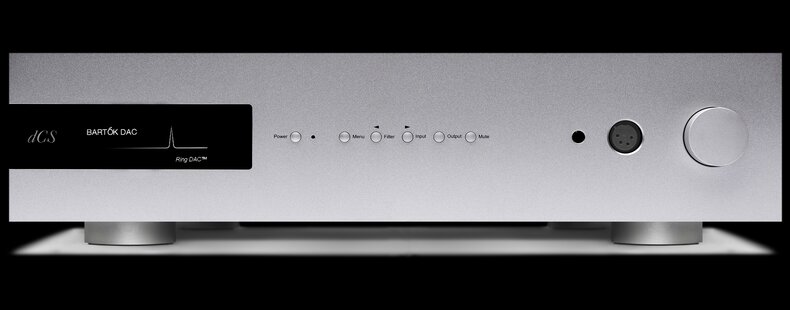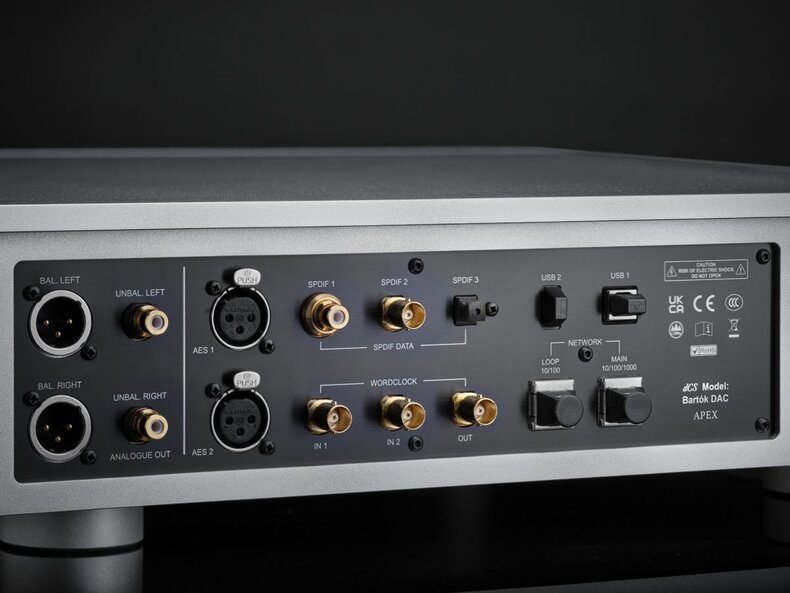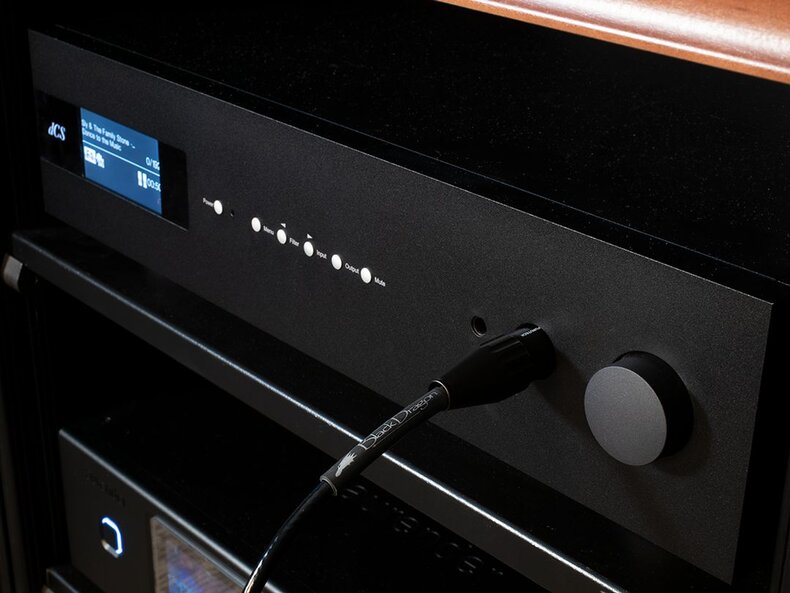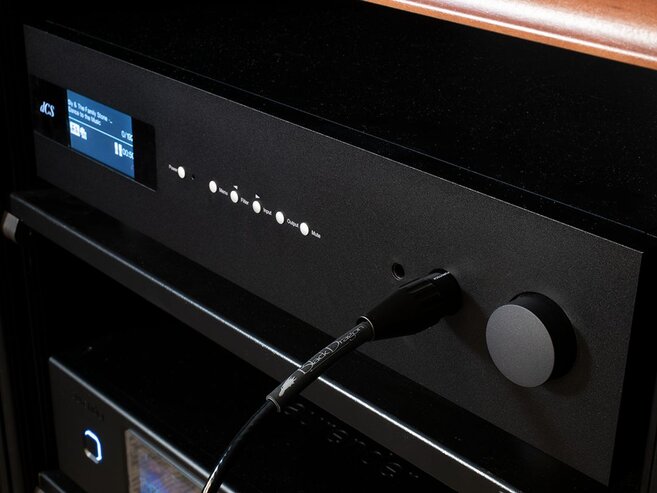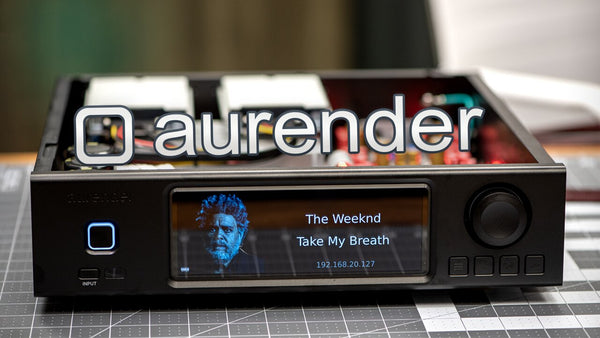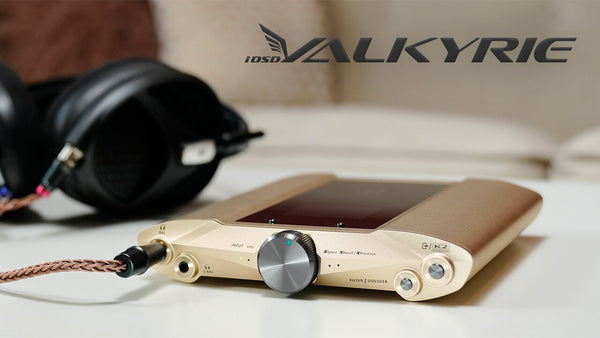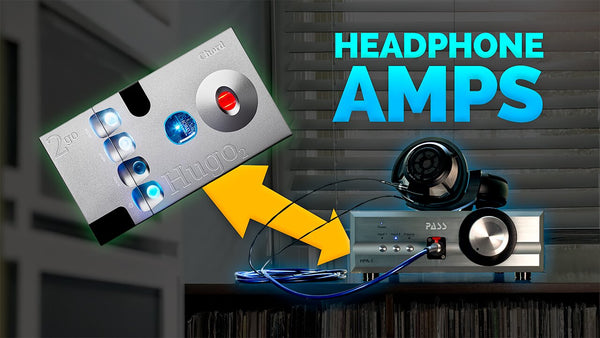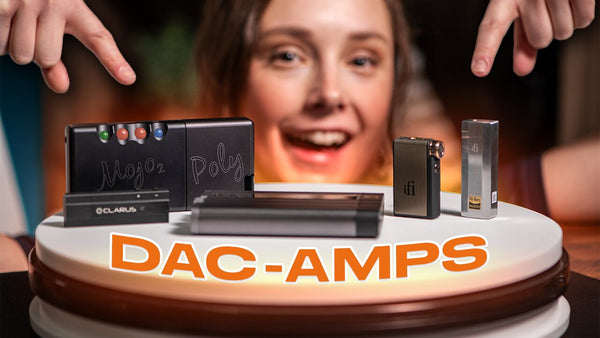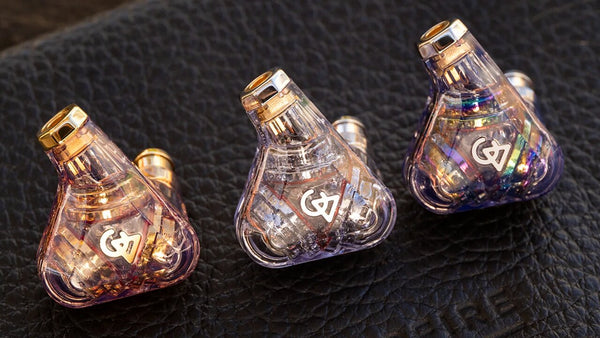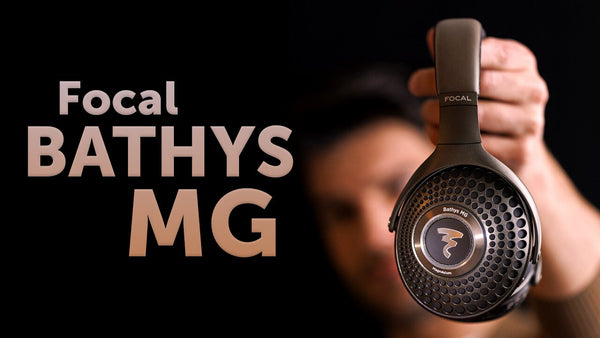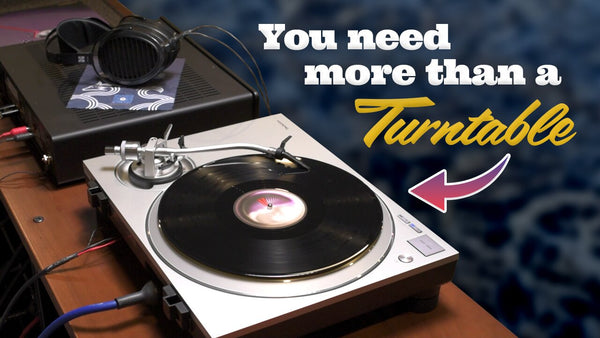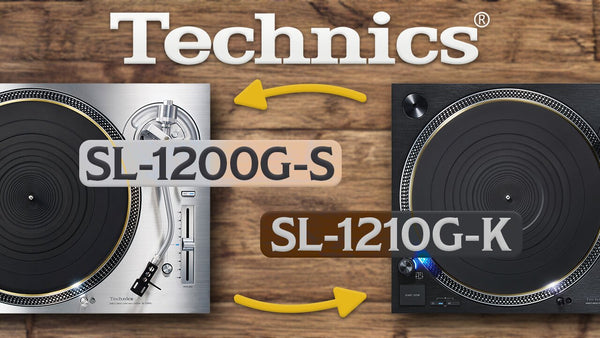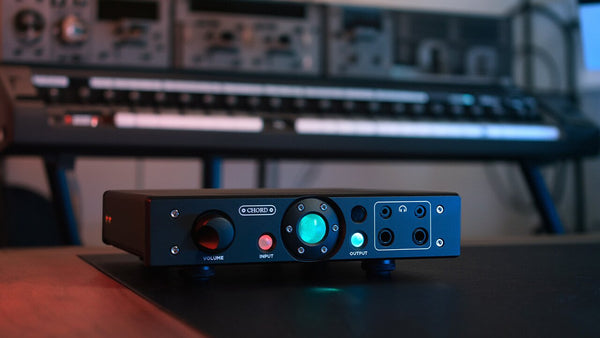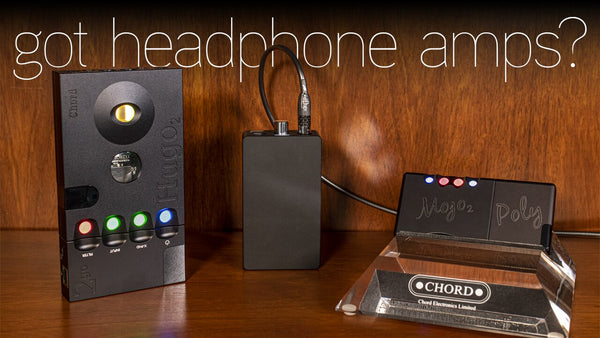Immersive Audio Redefined: dCS Bartók APEX DAC & Headphone Amp Review

The Ultimate Audiophile Experience and so much more...
Every legendary hi-fi product has a compelling story behind it and the Bartók APEX DAC/Headphone Amplifier is one of those products. Like other dCS products, the Bartók is named on behalf of a classical composer — in this case, the 20th Century Hungarian composer perhaps most well known for his Concerto for Orchestra. Having died in 1945, Bartók was a relatively modern-day composer, hence the Bartók APEX being called the "Modernist" of the dCS product line. Yet the technology and functionality behind the dCS Bartók APEX were far from the horizon during Bartok's lifetime.
Designed for the discerning audiophile, the Bartók APEX DAC/Headphone Amplifier combines the functionality of a music streamer, upsampler, preamp, and headphone amp into one state-of-the-art unit. While it doesn't include Bluetooth connectivity, it offers a wide range of wired connection options. The Bartók APEX is compatible with various headphones, from high-end open-back models to IEMs (In-Ear Monitors), and can drive headphones from brands like Sennheiser and Audeze with ease. The Bartók APEX is the upgraded version of the original Bartók DAC/Headphone Amplifier. The difference? The implementation of the APEX Ring DAC, dCS' next-generation DAC hardware. The result? A more profound listening experience, reducing noise and increasing linearity by over 12dB. Users with the original Bartók and 2.0 versions don't have to miss out; they can upgrade their system with dCS' APEX technology. The Bartók APEX comes in two variants: A standalone DAC and a DAC/Headphone Amplifier combo unit.
Users looking for a comprehensive digital audio solution to their setup will be delighted with the Bartók APEX's innovative technology and feature set. The Bartók APEX offers a singular experience for headphone and stereo listeners, taking audio performance to a new level that many audiophiles only dream of. The art of innovation and craftsmanship is evident throughout dCS' entire product line as the company constantly pushes the boundaries of performance, setting a new precedent for audiophile gear.

"Who is the Bartók APEX for? The audiophile chasing the pursuit of sonic perfection. These are world-class stacks. Endgame units that I could live with for the rest of my life. I get asked all the time 'Is it worth spending this kind of money on a unit? Is it going to be obsolete any time soon?' The Answer: No. The Bartók APEX has upgradable software and hardware paths, and dCS puts a lot of effort into innovating its products, releasing minor and major updates so you can enjoy your Bartók APEX for a long, long time. You get what you pay for. When you look inside the Bartók APEX you have this 'holy crap' moment. It's loaded with tech. You can go to Walmart and buy a $5 watch or buy a $20,000 Rolex. Both will tell time but only one is a timepiece that will last you ages."

PROS
- Profound levels of resolution and realism
- Crisp and musical sound signature
- Headphone amp works with low and high-impedance headphones
- Flexible, futureproof design
CONS
- Heavy and Large
- Price may be a deterrent
Design
The Bartók APEX takes design cues from dCS' award-winning Rossini range. Available in black or silver, it's got an elegant, minimalistic aesthetic that many modernists love. It's crafted from aerospace-grade machined aluminum with internal acoustic damping panels to reduce sound-degrading mechanical vibration and magnetic effects. Multi-stage power regulation is employed, with twin mains transformers to isolate the DAC circuitry from the headphone amplifier.
Physically, the Bartók APEX takes up a fair amount of real estate. It measures 17" deep, 4.6 inches high, and 17.5 inches long. At 36.8 lbs., once you find a spot for it, you probably won't want to move it unless absolutely necessary. And really, it sounds so good, I have no desire to part with it. With sharp edges and a minimalist design, it's quite striking and will stand out in your home audio setup.
The front panel, while large, has a clean and uncluttered appearance. It features a hi-resolution display screen, several buttons (power, menu, filter, input, output, and mute), two headphone inputs (4-pin balanced XLR and 6.3mm [1/4-inch] RCA), and a small volume control knob.
The rear panel of the Bartók APEX contains the connections for balanced and unbalanced analog audio outputs as well as S/PDIF (coaxial and TOSLINK), AES, and USB inputs for connection to the computer and/or formatted flash drive or NAS drive. There are also Ethernet and IEC connectors as well as connectors for adding an external master clock should you choose to do so. All of the unit's functionality can be controlled using the front panel buttons as well as the dCS Mosaic App, available on iOS and Android devices. The Mosaic App gives you a more in-depth view of the unit's settings, functions, filter options, etc. This is also where you can find any software updates.
Sound
"Well do you ever get the feeling that the story's too [darn] real and in the present tense? Or that everybody's on the stage and it seems like you're the only person sitting in the audience?"- Jethro Tull, "Skating Away on the Thin Ice of a New Day"
This quote from Jethro Tull comes from a song that I used for much of my testing with the Bartók APEX (and many of the other products I test). I find it to be particularly appropriate for the Bartok, because when listening, you will have the feeling not of being trapped in the audience, but of being on the stage with your favorite performers.
If "realism" were a quality that could be captured, packaged, and sold, the Bartók APEX would be the vessel. Of course, "realism" in digital recordings is achieved by degrees. Most high-end audio products deliver a realistic, lifelike sound. You might think you've heard "the one," and then you hear something else that sounds even more realistic. The Bartók APEX is "even more." The level of realism is such that it might even sound "over real," if that's even a thing. (And if it is a thing, it most certainly isn't a bad thing, right?)
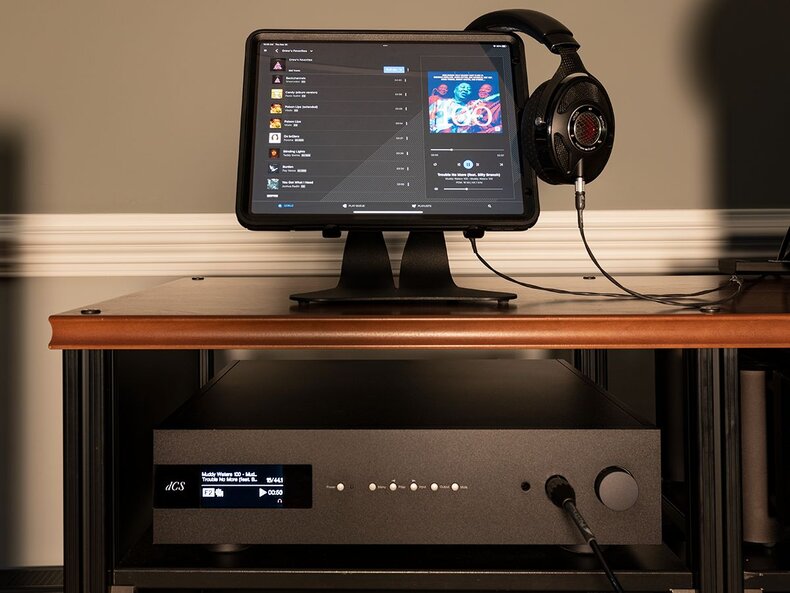
Pictured: dCS Bartók APEX, Focal Utopia 2022 Headphones, Silver Dragon Premium Headphone Cable
The Bartók APEX's signature leans analytical, but it's not sterile. It's got some natural musicality to it. The sound is crisp, clear, immersive, dynamic, powerful, and detail-rich. I'm talking layers upon layers of detail. Subtleties are revealed and emotions are triggered. Highs are airy and sweet, mids are immersive and present, and bass is clean, deep, and robust. If one frequency was crowding out or dominating the others, I couldn't hear it.
Listening to "Skating Away," I felt like I was hearing it for the first and not the 200th time. Let's start with the opening sequence, where Ian Anderson is making tea. This hit me on a whole new level of immediacy and realism. My mind had no doubt that I was at a small table with him while he clinked his teaspoon against the side of his cup and slurped his freshly brewed tea.
The Bartók APEX showed its chops with the instrument separation on this song, allowing flute, bells, guitar, and more to coexist and shine without getting in each other's way. It was an auditory delight. When guitar blasts were juxtaposed with delicate flute, neither lost its footing. Now, it's difficult to describe realism as a sound; you know it when you hear it. Something turns on in your brain and says, "Wow, this sounds as much like a flute as I've ever heard." And that's the experience I had. Vocals were simply out of this world, rich with texture, dimension, and emotion.
Listening to Bartok's Violin Concerto No. 2, I was blown away by the clarity and sweetness of the sound. The violins weren't just playing notes, they were evoking images of billowing sheets of satin swaying dreamily in my mind. During the most quiet, spare sections of the piece, as well as during the louder, more aggressive sections, the Bartók APEX kept everything cohesive and dynamically stable, such that I never had to adjust the volume knob. In this piece and everything else I listened to, the sound was projected generously out to either side.
On a whim, I called up The Final Cut from Pink Floyd, one of my favorite albums from yesteryear. The Final Cut is Roger Waters' tribute to his father, who died during Rogers' infancy during World War II. The album is full of scathing songs and gut-wrenching reminiscences, with searing vocals, gorgeous melodies, and tons of lifelike sound effects (birds, motors, etc. The first track, The Post War Dream, left me dumbfounded and reaching for my coat to warm me up from the chills that were making their way up my arms. The song opens with a motor whizzing, followed by a radio dial being tinkered with. Waters' vocals enter with such force, such emotion. You can hear every single thing happening inside his mouth, from his teeth hitting his lips to the enunciation of consonants like "d" and "t." Those are the things that really bring music to life and make you feel like you have a front-row seat to a personal performance.
One thing that strikes me about the Bartók APEX is that individual elements of compositions — the pluck of a guitar string, a piano note, an intake of breath — seem to have bodies and lives all their own. It's like they are at once contributing to a larger whole while also being their own separate entities worthy of examination and enjoyment. The fact that I am noticing this points to the fact that the Bartók APEX has a more analytical sound, one where a focus on details and nuance is inherent. Listening to the Bartók APEX with the Focal Utopia, which is a highly detailed and analytical headphone, would very much appeal to people who enjoy critical listening. Objectively, this combination sounded amazing. However, I preferred the Bartok paired with the HiFiMan SUSVARA, which is also a detailed headphone but has a more musical sound than the Utopia.

The Post War Dream
by Pink Floyd
(Album Title)

Dock of the Bay
by Otis Redding
(Album Title)

Diamonds and Rust
by Joan Baez
(Album Title)

Skating Away on the Thin Ice of a New Day
by Jethro Tull
(Album Title)
Technology & Features
The Headphone Amplifier
HeadFi Reimagined: The Bartók APEX’s custom headphone amplifier is the embodiment of our uncompromising approach to design. Starting with the dCS analog output stage, benchmark performance is maintained with true Class A operation through its balanced and unbalanced outputs. Engineered to deliver a spectacular experience on both high and low impedance headphones, in balanced and unbalanced formats, it is able to handle a vast range of headphone models regardless of efficiency or impedance. Its design also features dedicated power supplies for analog and digital processing, which are isolated from the DAC section of the system for enhanced precision with minimal crosstalk and noise. This unique architecture allows us to deliver a powerful and transparent performance that uncovers the unique character and potential of your chosen headphones.
Headphone use is simple: just plug in your chosen pair, switch the line output, and adjust volume levels using the volume dial or our Mosaic control app (no need for a separate preamp). With a choice of four adjustable gain settings, you can adjust its performance to suit your setup, ensuring optimal sound across a vast range of systems. Along with its groundbreaking amplifier, the Bartók APEX Headphone DAC features a unique processing platform that reimagines how sound is optimized for headphones. Expanse is an optional feature that can be engaged with a wide range of stereo recordings to provide a heightened sense of realism, and a greater sense of space and depth. -dCS Audio
With more and more audiophiles listening to headphones, it's wonderful that dCS chose to include a headphone amplifier option with the Bartók APEX. This Class A headphone output stage uses an all-discrete transistor design along with its own dedicated power supply. The headphone amplifier is a custom design that works extremely well with both high and low impedance headphones in balanced or unbalanced formats, providing an ample amount of amplification. All of the outputs can be set to one of four maximum levels to enhance system compatibility. It's got dedicated power supplies for analog and digital processing (isolated from the DAC section). With dCS' patent-pending Expanse technology, the headphone experience moves closer to the studio experience. Its unique processing method replicates the effects of studio listening, where sound is projected into the space around us rather than inside our heads, without altering the reverb in a recording or affecting a system's performance. The headphone amplifier can be used as a standalone preamplifier to control the volume of connected power amplifiers or active speakers.
dCS Expanse: Rethinking the Headphone Experience
When we listen to music on headphones, the sound is projected inside our head, where it forms an arc between both ears. Sounds from the left channel of a stereo recording are sent to our left ear, and sounds from the right channel are sent to our right ear. Listening on loudspeakers is different because sound is projected into the room around us, where it reflects off of various surfaces before arriving at our ears. The signal from each speaker is also heard by both ears. In a loudspeaker setup, the reverberation that is generated from sound bouncing around and reflecting off of surfaces plays a crucial part in helping us to identify where in the image of a particular sound is coming from.
For headphone listeners, the absence of these spatial cues can result in a soundscape that feels unnatural. Depending on how a recording has been mixed or produced, we can be left with an experience where sounds appear to come from inside our head, or right next to one ear. For some listeners, this can cause fatigue during long listening sessions. Various technologies have set out to address this issue, including a technique known as crossfeed, which involves blending sound from the left and right channels of a stereo recording to simulate the effects of sound from each channel arriving at both ears.
Expanse uses a multi-stage processing method to replicate the effects of stereo listening - where sound is projected into the room around us, rather than inside our heads - without damaging or altering reverberation or affecting a system's performance. This is achieved through widening audio signals prior to the crossfeed phase. Expanse also delays the delivery of crossfeed signals to recreate the effect of left and right audio signals arriving at our ears at different times. Together, these methods help to bring the headphone experience closer to loudspeaker monitoring, while preserving the unique sound and character of a system and a listener's own headphones.
In a further stage of optimization, Expanse draws on a vast range of data to equalize audio and simulate the effects of sounds reverberating off our bodies including our heads, torso, or ears, without using methods that would favor one particular set of physical characteristics over another. This technique allows dCS to recreate the original soundscape in a recording while preserving the unique tone and timbre of a performance. Because the effects of headphone optimization are dependent on how a recording is mixed or produced, Expanse isn't suitable for all types of music, but when used with the right track, such as those featured in the Expanse playlist, it can provide a heightened sense of space and depth, and a more natural and immersive soundscape. Expanse can be turned on and off easily in the dCS Mosaic App.
dCS Mosaic App
Mosaic is dCS' proprietary software that allows you to browse and play music from any device running iOS or Android. Mosaic consists of three elements:
- dCS Mosaic is the name for the audio streaming and networked control functionality of dCS products
- dCS Mosaic Control is the name of the iOS and Android software application for music management and product control
- dCS Mosaic Processor is the physical hardware component and associated software that is installed in the dCS products to provide streaming functionality
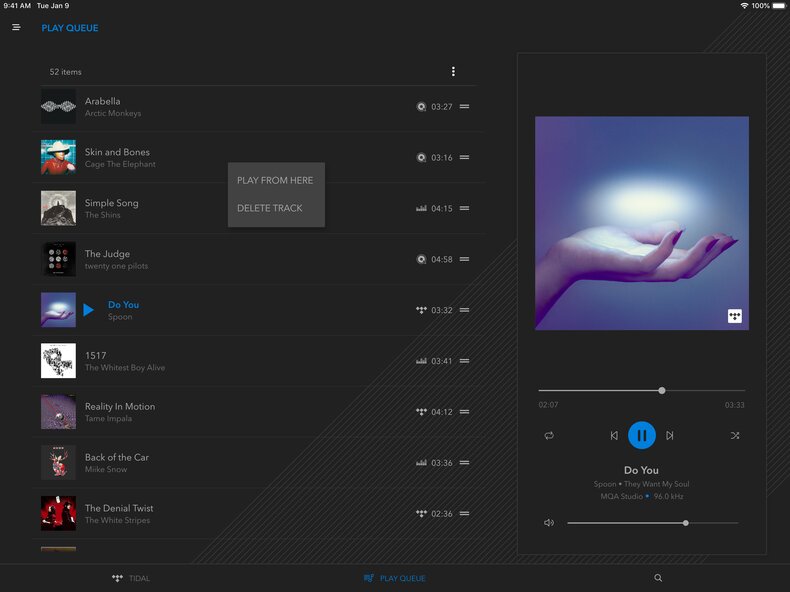
Mosaic brings together audio from multiple sources into a single, unified interface, making multi-source playback simple. You can use Mosaic to tailor settings on your dCS device. Mosaic also has enhanced streaming functionality, allowing you to stream with TIDAL, Qobuz, Deezer, podcasts, or internet radio. You can also use Spotify via the Spotify Connect app.
Now, if you don't want to use Mosaic to stream TIDAL or Qobuz, you also have the option of using Roon. Why might you opt to run Roon instead of Mosaic? It comes down to user experience. Mosaic is more of a minimalist approach. Calling up Qobuz on Mosaic, for example, gives me a bare-bones, clutter-free screen. Roon provides a more curated experience, with lots of rich metadata including extensive bios, music suggestions, visual elements, and much more. When I call up the Roon home screen, I'm greeted with stats, recent activity, suggestions, playlists, and more. When I click on a track, I get tons of info right there, including an album review. Now, some of this information is available with Mosaic, but you have to click for it. Using Qobuz, for example, I clicked on the three vertical dots that appear next to each track listing. From there, you can access artist, track, and album information. You can also go to the album or artist, add a track to a playlist or queue, or play directly. A great thing about Mosaic is that it's a custom code developed by dCS that can be upgraded and enhanced over time. Neither Roon nor Mosaic is the better choice; it all comes down to user preference. And it's great to have the option to use either.
dCS Ring DAC APEX
The heart and soul of the Bartók APEX is dCS' proprietary APEX Ring DAC. As dCS' latest generation DAC board, the APEX Ring DAC is equipped with several major sonic upgrades over the original Ring DAC. dCS builds its Ring DACs from the ground up; there are no off-the-shelf DAC chips. The Ring DAC’s circuit board has been configured and developed with a new analog output stage. This allows for further enhanced distortion and increased linearity, resulting in a range of measured and sonic improvements, including a greater sense of dynamic range, detail, and vitality. dCS has also upgraded the reference voltage and clocking signal path and reduced the 3rd-order harmonic distortion. By reworking the analog output circuitry with a new technique used for the transistors (compound pairs instead of individual units), dCS has reduced 3rd-order harmonic distortion by 12dB over the original's -120dB rating. The Bartók APEX also has a lower impedance level for the signal path when feeding the clock signal to the Ring DAC latches and current sources. This results in more resilience to differences in the impedance of the current sources as the latches turn on and off.


The new Ring DAC APEX hardware is available to both new and existing dCS customers. New APEX editions of the dCS Vivaldi DAC, Rossini DAC, Rossini Player, and dCS Bartók feature the new Ring DAC APEX hardware as the standard. Existing Vivaldi DAC, Vivaldi One, Rossini DAC, Rossini Player, and Bartók owners can upgrade their system to feature the APEX hardware.
dCS' Ring DAC seeks to correct the issues that are inherent in ladder DACs.
The Ring DAC uses a network of FPGAs (field programmable gate arrays) that are running proprietary dCS software that performs the digital to analog conversion as well as the digital filtering. A couple of things to note about the Ring DAC that make it different from a ladder DAC. A key point here is that the ladder DAC removes the link between the original signal and the physical resistor value errors associated with specific sample values. The Ring DAC does not use the same current(s) for the same bit every time, and instead uses current sources of equal value.
One of the key advantages of the Ring DAC is its upgradeability via firmware updates. Unlike the Ring DAC in the Vivaldi and the Rossini, the one in the Bartók APEX uses a double power supply, one of which powers the headphone amplifier.
Featuring DXD upsampling as standard, the Ring DAC's multi-stage oversampling design offers optional DSD upsampling plus an extensive selection of DSP filters to suit individual taste and music choices. You've got four filters with DSD content, plus six filters with PCM. I played around with PCM filtering and found the differences to be subtle, with Filter 4 offering a discernible lift in warmth and fullness to the sound. The Bartók APEX is compatible with all major file formats, providing instant access to music from a wide range of streaming services including Roon, TIDAL, Spotify, Qobuz, Deezer, and Internet Radio. It also plays files direct from personal devices or storage devices via USB, AES, or S/PDIF inputs, and from Apple devices using Apple AirPlay.
Digital Clocking
dCS is a pioneer in the use of external clocks in digital audio systems, using quartz crystal oscillators as the basis of its clocking systems. The Bartók APEX includes the clocking architecture from the dCS Vivaldi master clock. In audio systems with multiple units, an external clock helps to ensure that all of the components, like DACs and streamers, are operating in sync. This is important for reducing the occurrence of jitter. In the case of a DAC, for example, one of its main tasks is to convert digital audio samples into analog signals. The timing of this process is crucial to ensuring the audio we hear is an accurate representation of a musical event. If audio signals aren't converted by the DAC at just the right moment, you get an artificially distorted version of the music.
When you're running multiple audio devices that are processing the same audio, you need something that will keep playback in sync, regardless of the sample rate. That something is a master clock. While the DAC in the Bartók APEX could be configured to act as a master clock, tests have shown that there is no substitute for having a dedicated clock. Having an external master clock allows dCS to isolate a clock's sensitive circuitry from the other circuits within a system and ensure that the clock signals aren't affected by crosstalk (electromagnetic leakage), physical movement (such as the act of a disc spinning), or power interference (which can occur when multiple circuits are fed with the same power supply). With a master clock in place, all aspects of the sound are enhanced, from detail and imaging to rhythmic movement and flow.
Now, you do have the option of adding the Vivaldi (or other) external clock to the Bartók APEX. That is a personal as well as a financial decision, but anecdotal evidence points to significant gains in sound quality in what is generally considered to be an already top-tier DAC.
Dragon Cables
[Silver Dragon Network Cable, Silver Dragon Interconnect Cable, Black Dragon AES Digital Cable, Black Dragon Power Cable]
We recommend pairing the dCS Bartók APEX DAC Headphone Amplifier with the Silver Dragon Network Cable to provide a stable internet connection. The Silver Dragon Network Cable delivers high speed, low latency, and low jitter-perfect bit rate communication between audio components. For audio device interlinking, we recommend our Silver Dragon Interconnect Cable with XLR connectors. This will allow you to connect the Bartók APEX to other devices within your setup. With a braided geometry and amazing shielding, this interconnect is a remarkable solution where noise isolation is key.
Our Black Dragon AES Digital Cable with XLR connectors for all your high-end audio digital applications. Some uses are to connect a CD Transport or computer's Pro Audio Card like a Lynx to an outboard digital to analog converter. Lastly, we recommend powering the unit with the Black Dragon Power Cable. The Black Dragon Power Cable is the ultimate power cable designed to be dead quiet and reject all EMI and RFI interference. 4-11Awg Stranded high purity slow drawn Copper conductors are used per cable in a star Quad configuration. The cable has a single 100% coverage shield but can be doubled up for noisy environments plus it is relatively flexible.
Our HiFi Audio Dragon Cables bring out more of what you love in your music and audio gear. If you love your headphones but wish they had a bit more top-end sparkle - a Silver Dragon Headphone Cable would be a great option. If your USB cables keep dying - as many stock cables do - then check out our quality USB Audio Cables. We say time and time again that materials matter, and our audio cables and custom geometries actually help to bring out those desired properties in your gear and music. We make tons of custom options for our customers so that you can get the right HiFi Audio cable for your exact needs. If you have any questions feel free to Contact Us and we'll be more than happy to help.
Verdict
While the Bartók APEX may sport a premium price tag, you should know that it's worth every penny and more. Although everyone may advertise it, there are only a handful of hi-fi components that truly deliver on the price-to-performance ratio. dCS' innovation spans far beyond its technology, expertly crafting every product line and component, from the Bartók to the Lina, Rossini, and Vivaldi, to be unique. Take the Lina Network DAC for instance. The unit's chassis is constructed of one solid piece of aluminum billet. That alone is incredibly rare, does wonders for the performance, and is worth every penny. That type of ingenuity is hard to come by so when you find it, jump on it because you won't be disappointed.
The Bartók APEX is an endgame component for a reason. You buy the Bartók APEX for its longevity—because it lasts. It's got an upgradeable software and hardware path, and given dCS' thirst for innovation, there will be plenty of available upgrades throughout its lifetime. If you've been waiting for 'the one', that quintessential piece that will complete your audio setup, and satisfy that itch for the pursuit of the sonic perfection, invest in the Bartók APEX. The BartókAPEX will make your music sound astonishingly clear and lifelike, with spine-tingling layers of resolution and an "I'm there" in the concert hall or studio feeling. Chock full of features and firmware upgradeable, the Bartók APEX DAC/Headphone Amplifier could well be your ticket to audio nirvana, now and for years to come.
Featured Products
Related Videos
Audiophile Eye Candy: Tour Our HQ's Demo Room
Sennheiser HD 620S Unboxing & Sound Impressions
Astell&Kern SP3000T Review: 5 Reasons It's The Most Versatile DAP Ever
What's in the Box
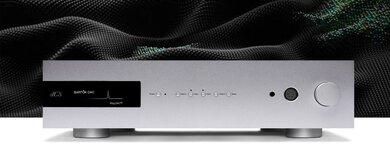
- dCS Bartók APEX DAC Headphone Amplifier
- User Guide
- Software Quick Start Guide
- Quick Reference Guide for the Mosaic Control app
- Power Cable
Specifications
- Type: Upsampling Network DAC with Headphone Amplifier
- Color: Silver or Black
- Dimensions: 17.5” x 17.0” x 4.6“. Allow extra depth for cable connectors.
- Weight: 16.7kg / 36.8lbs
- Converter Type: dCS proprietary Ring DAC™ topology
- Digital Inputs: Network interface on an RJ45 connector – acts as a UPnP™ renderer in Asynchronous mode, streaming digital music from a NAS or local computer over a standard Ethernet network, decoding all major lossless formats including FLAC, WAV & AIFF at up to 24 bit 384kS/s native sample rate, plus DSD/64 & DSD/128 in DFF/DSF format. Other formats include WMA, ALAC, MP3, AAC & OGG. Some formats are limited to lower sample rates. Supports Apple AirPlay at 44.1 or 48kS/s. Network Loop Out connector on a second RJ45 connector. USB 2.0 interface on a B-type connector operating in Asynchronous mode, will accept up to 24 bit PCM at up to 384kS/s plus DSD/64 & DSD/128 in DoP format. Operates in Class 1 or 2 mode. USB-on-the-go interface on type A connector operating in Asynchronous mode, streams digital music from a flash drive at up to 24 bit 384kS/s plus DSD/64. 2x AES/EBU on 3-pin female XLR connectors. Each will accept PCM at up to 24 bit 192kS/s or DSD/128 in DoP format. Used as a Dual AES pair, it will accept PCM at up to 384kS/s, DSD/64 & DSD/128 in DoP format or dCS-encrypted DSD. 2x SPDIF on 1x RCA Phono and 1x BNC connectors. Each will accept PCM at up to 24 bit 192kS/s or DSD/64 in DoP format. 1x SPDIF optical on a Toslink connector will accept PCM at up to 24 bit 96kS/s
- Analog Outputs: Output levels: 0.2, 0.6, 2 or 6V rms for full-scale input, set in the menu. Balanced outputs: 1 stereo pair on 2x 3-pin XLR male connectors. These outputs are electronically balanced and floating. Output impedance is 3Ω, maximum load is 600Ω (10k-100kΩ is recommended). Unbalanced outputs: 1 stereo pair on 2x RCA phono connectors. Output impedance is 52Ω, maximum load is 600Ω (10k-100kΩ is recommended).
- Headphone Outputs: 1 stereo balanced pair on 1x 4-way male XLR connector. 1 stereo unbalanced pair on 1x 6.35mm (1/4”) 3-pole jack. Full-scale output levels are 1.4W rms into 33Ω, 0.15W rms into 300Ω. Output levels are 0, -10, -20, -30dB, set in the menu. Minimum headphone impedance is 33Ω.
- Wordclock I/O: 2x Word Clock Inputs on 2x BNC connectors, accept standard word clock at 44.1, 48, 88.2, 96, 176.4 or 192kHz. The data rate can be the same as the clock rate or an exact multiple of the clock rate. Sensitive to TTL levels. Word Clock Output on 1x BNC connector. In Master mode, a TTL-compatible word clock appears on this output.
- MQA: Full decoding and rendering of MQA data from the Network and USB2 inputs. Final rendering of unfolded MQA data only from the other inputs.
- Residual Noise: 24-bit data: Better than –113dB0, 20Hz - 20kHz unweighted. (6V output setting)
- L R Crosstalk: Better than -115dB0, 20Hz – 20kHz
- Spurious Responses: Better than -105dB0, 20Hz – 20kHz
- Filters: PCM mode: up to 6 filters give different trade-offs between the Nyquist image rejection and the phase response. DSD mode: 4 filters progressively reduce out-of-audio band noise level.
- Conversions: DXD as standard or optional DSD upsampling
- Software Updates: Download and update functionality available via Bartók App
- Local Control: dCS Bartók app for unit configuration and playback. RS232 interface (controlled by a 3rd party automation system). dCS Universal IR remote control is available as an optional extra.
- Power Supply: Factory set to either 100, 115/120, 220 or 230/240V AC 50/60Hz.
- Power Consumption: 30 Watts typical / 50 Watts maximum.




